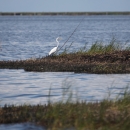The Lower Fox River, located in northeastern Wisconsin, begins at the Menasha and Neenah channels leading from Lake Winnebago and flows northeast for 39 miles where it discharges into Green Bay and Lake Michigan. Paper companies using polychlorinated biphenyls (PCBs) to make carbonless copy paper discharged nearly 700,000 pounds of these chemicals into the Fox River, between about 1954 and 1971. The dangers posed by PCBs were unknown until the early ´70s, but their use and discharge into the environment were outlawed by federal environmental regulations in 1976. The ban was successful, but because PCBs bind to dirt and break down very slowly, they are still found today in the sediment of the Lower Fox River and Green Bay.
A Natural Resource Damage Assessment (NRDA) of the Fox River and Green Bay identified companies that were historically responsible for the release of PCBs into the Fox River. Several of these companies have made agreements, through the NRDA process, to fund natural resource restoration projects in the Fox River Valley and surrounding areas. These projects include preserving habitat for wildlife, constructing environmental education centers and nature trails, and studying the feasibility of reintroducing wild rice in certain areas of the state.
For more information visit the Fox River Trustee Council website.





